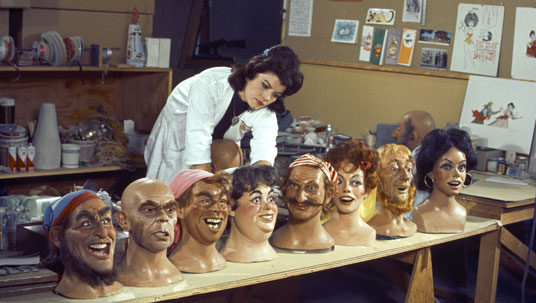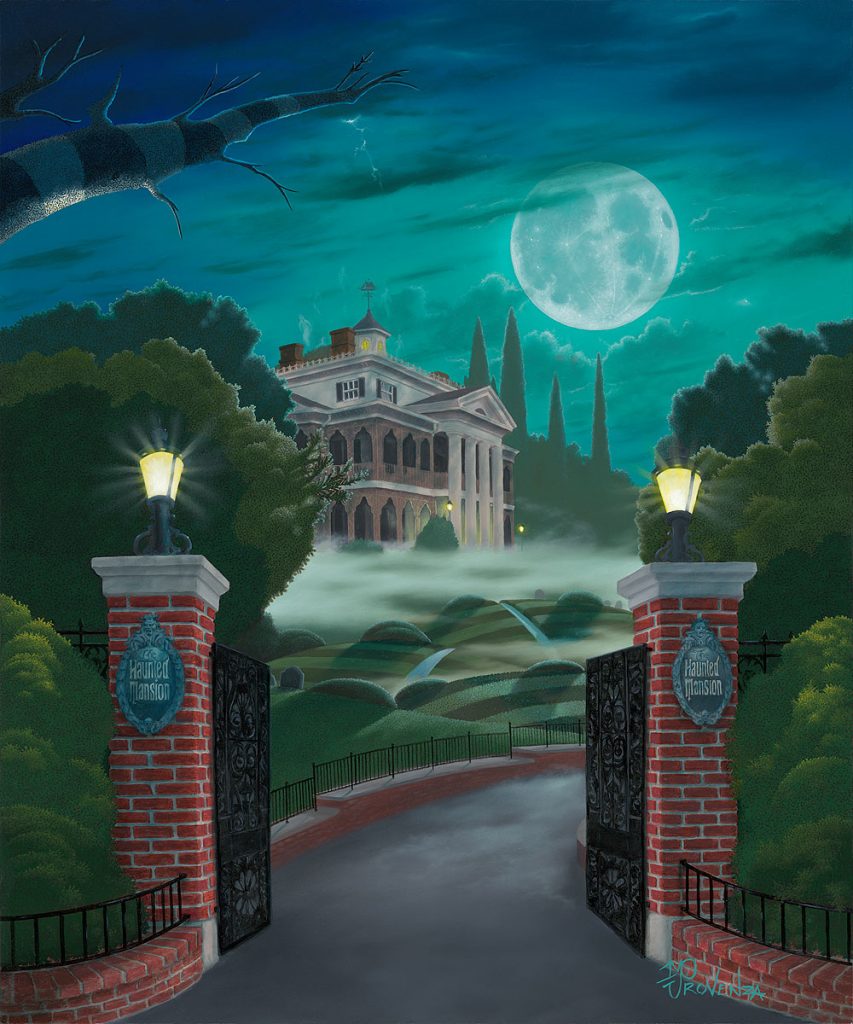I can’t believe after more than 30 years selling Disney art, this is the first time the art Disney’s Haunted Mansion has become available. It inspired me to write about my favorite Disney attraction.
In the many times I’ve gone to Disney World and Disneyland for work or for fun, the Haunted Mansion has always been a highlight, and I’d even say one of the main reasons we’ve gone to the parks. There was one visit in which Disney Studios had closed the park for us to wander around unimpeded, and we went through the mansion repeatedly at near midnight with only friends surrounding us. Those experiences only enhanced what is a magical experience even after waiting hours to ride it, and I should know. I’ve done that, too. That made me curious. What was the process the famous artistic and engineering geniuses at Disney Imagineering that resulted in a ride that has withstood the test of over 50 years and multiple generations? What secrets does it hold?
The Haunted Mansions for both Disneyland and Disney World were built at the same time, in 1969. By then, they already knew they’d be opening Disney World, so they made two of every element of the attraction.
The idea for it came before Disneyland, way back when Walt was going to create his park across from Disney Studios. The first illustration that included some version of the attraction was drawn by Disney artist Harper Goff, then Disney assigned Imagineer, director, and animator extraordinaire Ken Anderson to create a story, which he did, based on a dilapidated antebellum manor styled after those in and around New Orleans, which he studied copiously in the process of his designs. His house had swarms of bats, boarded up doors and windows, overgrown with weeds. Walt rejected it, thinking a run-down house inside his park sent the wrong message. Instead, he suggested as inspiration the Winchester Mystery House in San Jose, and Anderson took that and ran with it, writing stories about former residents turned evil ghosts. Two imagineers known as integral to the design and engineering of the attraction, Rolly Crump and Yale Gracey took his stories and brought them to life for the park. The Haunted Mansion was expected to open in 1963, and construction started in 1962, with the exterior finished by 1963.
It was largely inspired and modeled after a Victorian Era manor called the Shipley-Lydecker House in Baltimore Maryland.
Famed animator and background artist Marc Davis and Claude Coats partnered in the feel of the ride’s interior, with Coats contributing the scarier elements and Davis bringing a comedic and less spooky quality. Plans for an opening stalled first because of the New York World’s Fair, then because of Walt’s death in 1966. After Walt passed, there were a few major changes to the ride. They scrapped an idea for a “Museum of the Weird, which would include a restaurant like the Blue Bayou at the Pirates of the Caribbean. What was once going to be a walk-through attraction became one with what became the famous “Doom Buggies”.
The Haunted Mansion at finally Disneyland premiered opened with a press event at midnight on August 12th, with an opening for the public later that morning. It was an immediate success. Within a week of opening, Disneyland celebrated its highest single-day attendance.
One thing that makes the attraction special is the wonderful Ghost Host. Foolish mortals are welcomed to the mansion by a disembodied voice, originally supplied by one of the most famous voices in animation, Paul Frees. Even legendary voice artist Mel Blanc called Frees “The Man of a Thousand Voices”. Not only did Frees have a long and storied career with Disney, he also provided voices for Rocky and Bullwinkle’s Boris Badenov, was featured in nearly every Rankin Bass stop-motion cartoon, he was also the voice of Mr. Granite in The Flintstones, and played both John Lennon and George Harrison in a Beatles cartoon. The Ghost Host is also known as Master Grace, named in tribute to Yale Gracey.
Here is a vid with some early outtakes of his recordings as the Ghost Host:
As to the features of the attraction itself, there’s so much to love. A friend of mine bought the original stretching portraits from the Haunted Mansion a few years ago when Disney was foolish enough to get rid of them and that made me curious about their origin. There are four portraits, including a balding man, an old woman, a brown-haired man, and, my favorite, a tightrope walker. In an early script for the Haunted Mansion, the balding man was an ambassador named Alexander Nitrokoff. The old woman stretches to show her late husband’s bust. The brown-haired man is identified in the comics created in 2005, he and the two men sitting on each others’ shoulders are gamblers called Hobbs, Big Hobbs, and Skinny Hobbs. The tightrope walker has many alias, with Disney cast members calling her Lillian Gracey and the comics dubbing her Daisy de la Cruz. They say she’s a witch who turns men into crocodiles. I LIKE IT! Madame Leota might be the most popular character inside the mansion. She is a psychic medium originally voiced by Eleanor Audley, who voiced both Cinderella’s Lady Tremaine and Maleficent in Sleeping Beauty. Her face is based on imagineer Leota Toombs.

Of course one of the best moments on the ride is the ballroom dancers, usually called the Waltzing Dead by fans. There are a total of 12 dancers, 6 women and 6 men, that dance as couples. In the Ghost Gallery, which is a notebook written by cast members at the Magic Kingdom’s Haunted Mansion in which they created biographies for all the attractions’ characters, the ballroom dancers are meant to be souls of folks who attended a party at Gracey Manor, only to be cursed by Madame Leota for neglecting her.
Lastly and perhaps most memorable, the ride features the groundskeeper, his mangy pup, and the hitchhiking ghosts. The groundskeeper is sometimes referred to as The Caretaker, and there’s some question as to whether the shovel he holds is for his grounds work or for a second career grave robbing. In the comics, he is identified as Horace Fusslebottom.
The hitchhiking ghosts have become a thing of their own legend. They are referred to as Gus (The Prisoner), Ezra (The Skeleton) and Phineas (The Traveler), but those names are believed to have been invented by cast members and subsequently spread by visitors to the attraction. The Ghost Gallery imagines them as three cellmates at the Salem Asylum for the Criminally Insane.
It was a thrill when I was surprised a few days ago with what felt like, after so many years without any art, an avalanche of interpretive images of The Haunted Mansion was released by Disney Fine Art.




Click on any image above to find out more about the art, or you can see all the Haunted Mansion images by going to our Haunted Mansion art page HERE.
I’ll leave you with a wonderful clip from a 1970 Wonderful World of Disney episode in which Kurt Russell guides us through the Haunted Mansion at Disney:


